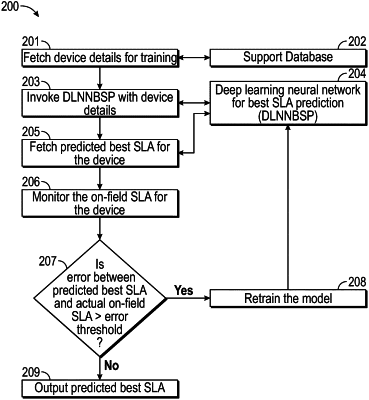| CPC G06Q 30/012 (2013.01) [G06Q 10/20 (2013.01); G06Q 50/28 (2013.01); H04W 28/24 (2013.01)] | 6 Claims |

|
1. A customized warranty system for providing a best possible service level agreement (SLA), comprising:
a processor; and
a memory coupled to the processor, the memory having program instructions stored thereon that, upon execution by the processor, cause the system to:
retrieve a data feature set comprising location and service-related parameters for Information Handling Systems (IHSs) to use as a training set for a deep learning neural network;
train an SLA model using the deep learning neural network by selecting random data features from the training set and building decision trees to calculate a best SLA for each respective data feature set, wherein the best SLA corresponds to an SLA with a fastest available replacement time and a highest available support type;
calculate a predicted best possible SLA for a specific IHS by averaging the best SLA of each data feature sets;
validate the predicted best possible SLA using an actual on-field SLA comprising actual service time and delivery time for IHSs to determine whether the predicted best possible SLA was met by determining whether the actual service time and delivery time are within a predefined threshold of the predicted best possible SLA;
if the predicted best possible SLA is above the predefined threshold, retrain the SLA model using the deep learning neural network using updated location, actual service time, and deliver time parameters until the predicted best possible SLA is below the predefined threshold;
if the predicted best possible SLA is below the predefined threshold, output the predicted best possible SLA as the best possible SLA.
|